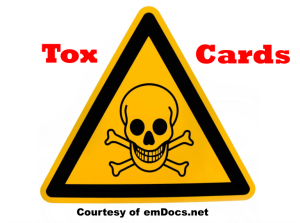Authors: Julie Furmick, DO (Pediatric Emergency Medicine Fellow, Atrium Health’s Carolinas Medical Center), Christine Murphy, MD (Emergency Medicine Attending, Medical Toxicologist, Atrium Health’s Carolinas Medical Center) // Reviewed by: Cynthia Santos, MD (@Cynthia Santos, MD); Alex Koyfman, MD (@EMHighAK); and Brit Long, MD (@long_brit)

Case:
A healthy, five-year-old boy presents to the emergency department for insomnia and agitation. He has normal vitals signs, normal head CT and a normal physical exam with the exception of a labile mood. He is admitted to the hospital, and his symptoms continue to worsen with the development of movement abnormalities, increasing agitation and aggression. No toxic exposures are identified, he has a normal brain MRI, additional testing is performed, and ultimately, he is diagnosed with NMDA receptor encephalitis.1
Question:
What is NMDA receptor encephalitis, and how common is it in the pediatric population?
Background:
Anti-NMDA receptor encephalitis is a very specific autoimmune mediated reaction against the NMDA receptor that leads to down regulation of the receptor presenting as a variety of psychiatric and neurologic symptoms. Originally described as a paraneoplastic syndrome and seen exclusively in women with ovarian teratomas, it has since been described in those without tumors. This disease process can affect all age groups but is more common in those < 50 years of age and females (75% of cases). 2-5 Additionally, anti-NMDA receptor encephalitis is a more common autoimmune encephalitis than other viral etiologies and is the second most common cause of encephalitis behind acute demyelinating encephalits.5 In one study of patients between > 6 months and 28 years of age referred to the California Encephalitis Project, anti-NMDA receptor encephalitis occurred more than four times as frequently as herpes simplex type 1, West Nile virus, or varicella-zoster virus.6
Pearls/Pitfalls:
- Patients present with a variety of psychiatric and neurologic symptoms.2
- About 50% of cases are associated with ovarian teratomas.3
- This is the most common autoimmune encephalitis in children after acute demyelinating encephalomyelitis.4
- Diagnostics:3,4
- Blood work is usually normal, though some patients will have elevations in CRP and CK.
- Head CT will be normal, and brain MRI is only abnormal in about 50% of patients.
- CSF often demonstrates a pleocytosis with lymphocytic predominance.
- EEG will show non-specific slowing.
- Important toxicologic mimics include alcohol, benzodiazepine, barbiturate and GHB withdrawal, drug-induced psychosis, neuroleptic malignant syndrome, and serotonin syndrome.
Presentation:5-8
The majority of the time, NMDA receptor encephalitis follows a specific pattern of presentation including a prodromal phase, psychotic phase and neurologic phase.5 Affected patients are more likely to have seizures, language dysfunction, psychosis, and autonomic instability than those with encephalitis due to other etiologies.6 Presentation in pediatric patients can be more equivocal and involve behavior abnormalities, agitation, insomnia, urinary incontinence, and progressive speech deterioration.7,8
Prodromal phase:
- Viral syndrome including fever, malaise and fatigue
Psychotic phase:
- Delusions
- Hallucinations
- Paranoia
- Patients often misdiagnosed with primary psychiatric disorders
Neurologic phase:
- Seizures
- Movement disorders
- Autonomic instability, including central hypoventilation
- Often less severe in pediatric than adult patient
Treatment:2
- If present, teratomas should be removed.
- First line therapies include IVIG plus high dose corticosteroids or plasma exchange.
- Relapses can occur in about 25% of patients.5
Key points:
- Anti-NMDA receptor encephalitis is an autoimmune reaction targeting the NMDA receptor.
- Patients present with both psychiatric and neurologic symptoms.
- 50% of cases are associated with ovarian teratomas.
- Labs and imaging can be normal.
- Treatment includes steroids + IVIG or plasmapheresis.
References:
- Goldberg T, Cellucci M. New onset insomnia in a pediatric patient: a case of anti-nmda receptor encephalitis. Case Reports in Pediatrics 2017. DOI: 1155/2017/4083785
- Granata T, Matricardi S, Ragona F, Freri E, Zibordi F, Andreetta F, Binelli S, Nardocci N. Pediatric NMDAR encephalitis: A single center observation study with a closer look at movement disorders. Official Journal of the European Paediatric Neurology Society 2018. 22(2): p. 301-307.
- Jiang Y, Ma J, Gong T, Hao H, Chen H. The diffuse involvement of anti-N-methyl-D-aspartate receptor encephalitis in brain: a case reports in pediatrics. BMC Neurology, 2019. 19(1): p. 230.
- Sai Y, Zhang X, Feng M, Tang J, Liao H, Tan L. Clinical diagnosis and treatment of pediatric anti‑N‑methyl‑D‑aspartate receptor encephalitis: A single center retrospective study. Experimental and Therapeutic Medicine 2018. 16(2): p. 1442-1448.
- Remy K, Custer JW, Cappell J, Foster CB, Garber NA, Walker LK, Simon L, Bagdure D. Pediatric anti-n-methyl-d-aspartate receptor encephalitis: a review with pooled analysis and critical care emphasis. Frontiers in Pediatrics 2017. 5: p 250.
- Gable MS, Sherriff H, Dalmau J, Tilley DH, Glaser CA. The frequency of autoimmune N-methyl-D-aspartate receptor encephalitis surpasses that of individual viral etiologies in young individuals enrolled in the California Encephalitis Project. Clin Infect Dis. 2012;54(7): 899-904.
- Mann A, NM Machado, Liu N, Abdul-Hussein M, Silver K, Afzal K. A multidisciplinary approach to the treatment of anti-NMDA receptor antibody encephalitis: a case and review of the literature. Journal of Neuropsychiatry Clinical Neuroscience 2012. 24(2): p. 245-254.
- Florance NR, Davis RL, Lam C, et al. Anti-N-methyl-D-aspartate receptar (NMDAR) encephalitis in children and adolescents. Am Neurol. 2009; 66:11-18.








